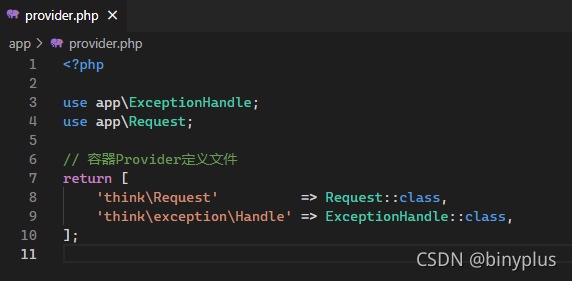日志级别
debug, info, notice, warning, error, critical, alert, emergency
其中有一个特别的级别:sql,专门用来记录sql语句的
对于程序比较重要的业务模块可以进行埋点(进行日志记录)
可以通过设置日志记录级别来开启和关闭记录
有助于排除错误(比每次出现错误去代码里增加记录日志好多了)
# 修改 config/log.php
# 配置 'level' => ['notice','warning']
# level 不为空时,只记录level中指定的错误级别
# level 为空时,记录所有级别
$user = UserService::getInstance()->findByUsername('xieruixiang');
Log::warning("warning:{user}", compact('user'));
# info 不再 level 中 则不会记录
Log::info("I'm info");默认的tp日志是写在当前日期(年月)目录下的,如(runtime/admin/log/202204/30_info.log)
单一日志设置 修改config/log.php 中通道single属性为true
设置单一日志后,将不再写在时间目录下(一直写一个固定目录),如(runtime/admin/log/single_info.log)
# 开启单一日志 # channels.file.single # 这里给file通道开启单一日志 'single' => true
每一种日志级别的日志都归类到一个文件之中(推荐开启独立日志)
设置 config/log.php 中通道apart_level属性
# 设置 file 通道 info,notice,warning 级别开启独立日志
# channels.file.apart_level
# 'apart_level' => ['info', 'notice', 'warning']
# 在 apart_level中的级别会独立写到一个文件中去
# write to runtime/admin/log/202204/30_warning.log
Log::warning("I'm ");
# write to runtime/admin/log/202204/30_info.log
Log::info("I'm info");
# write to runtime/admin/log/202204/30_notice.log
Log::notice("I'm notice");日志写入时机提供两种(实时写入,程序执行完后写入)
通过设置config/log.php中通道 realtime_write 属性
# 这里中断程序的执行
# 如果 realtime_write = false 则无法写到日志中去
# realtime_write = true 可以写入日志中去
Log::warning("I'm ");
# 如果 realtime_write = false
# 又想实时写入
# 可以通过 Log::write($msg, $type) 实时写入
# $msg 信息
# $type 日志级别
Log::write("I'm write", 'warning');
die("日志将不会写入");
可以自定义通道
以增加邮件通道为例
将config/log.php 中通道type 改成自定义驱动类即可
# config/log.php channels 添加
'email' => [
'type' => \app\admin\driver\EmailDriver::class,
# 调试发送邮件时将其设置成实时比较好调试
'realtime_write' => true,
]
# EmailDriver 需要实现 think\contract\LogHandlerInterface
class EmailDriver implements LogHandlerInterface
{
public function save(array $log): bool
{
# 这里进行发送邮件逻辑
# 想知道邮件发送逻辑的可以参考我的文章 《php发送邮件》
# 不想知道的 可以调用第三方封装好的php发送邮件组件
return true;
}
}使用邮件通道
# channel($channelName) 指定发送通道
# 不指定则使用默认发送通道
# config/log.php
# 'default' => env('log.channel', 'file'),
Log::channel('email')->info("this is info");
# 就能以邮件形式通知了目标:返回json格式的异常信息 # url_route_must:true强制路由模式下
thinkphp6内置已了一个app\ExceptionHandle异常处理类可供使用
该类绑定在app目录下面的provider.php文件中,直接修改该类的相关方法即可完成应用的自定义异常处理机制。

app\ExceptionHandle.php 异常处理类,重新定义render方法即可
#app\ExceptionHandle.php
public function render($request, Throwable $e): Response
{
// app_debug模式下按原thinkphp6异常模式处理异常
if (env('app_debug')) {
return parent::render($request, $e);
}
// 自定义json返回错误
if ($e instanceof ValidateException) {
return json($e->getError(), 422);
return json(['code' => 0, 'msg' => $e->getError()], 422);
}
// 自定义json返回异常
if ($e instanceof HttpException && $request->isAjax()) {
return json(['code' => 0, 'msg' => $e->getMessage()], $e->getStatusCode());
}
// 自定义json返回异常
if ($e instanceof HttpException) {
return json(['code' => 0, 'msg' => $e->getMessage()]);
}
// 自定义json返回异常
return json(['code' => 0, 'msg' => 'Biny服务器错误']);
}
目标:访问未定义的路由时返回json格式的信息 # url_route_must:false 非强制路由模式下
php think make:controller Error --plain
public function index()
{
return json([
'code' => 0,
'data' => 'Route is Not Found',
'msg' => 'success'
]);
}
public function __call($name, $arguments)
{
return json([
'code' => 0,
'data' => 'Route is Not Found',
'msg' => 'success'
]);
}

| 方法 | 描述 |
|---|---|
| record() | Log::record(‘record方法记录的日志信息不是实时保存的’,‘info’); |
| write() | Log::write(‘要实时记录的话,可以采用write方法’,‘info’); |
系统在请求结束后会自动调用Log::save方法统一进行日志信息写入
Log::close(); //手动关闭本次请求的日志写入
更多日志配置于app\config\log.php文件中配置,参考官方文档配置即可
官方日志文档
以上为个人经验,希望对您有所帮助。